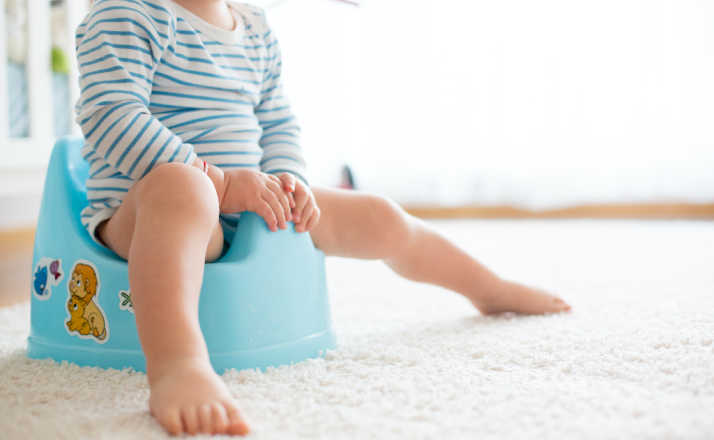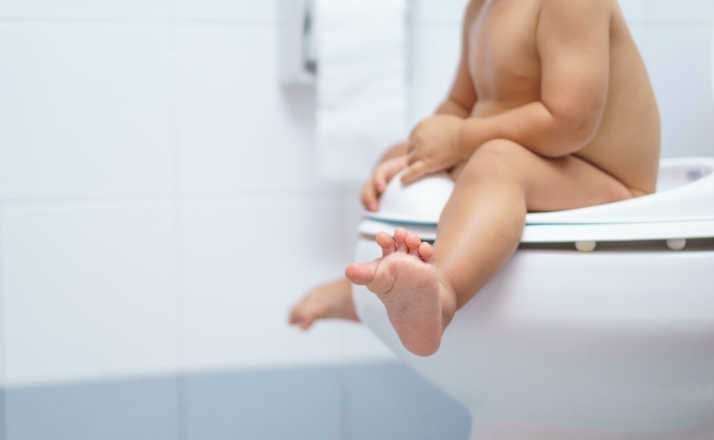Potty training is a rite of passage no parent can escape. And while it’s true that your child won’t be in Pull-Ups in university, when you are knee-deep in dirty diapers and massive blow-outs, college seems a long way off. Fortunately, there are a number of different potty training methods you can choose from so you don’t have to wait until your child is old enough to shave to use the toilet.
According to the Mayo Clinic, many children show signs of being physically and cognitively ready for potty training between ages 18 and 24 months. However, some children are not ready until the age of three. Boys typically start later and take longer to train than girls. The average age of potty training is 27 months.
Wondering if your child is ready to ditch the diapers? These are the signals to watch out for.
Signs of potty training readiness include:
Going longer periods between wet diapers. Waking up dry from naps or lasting for a couple of hours between changes indicates that your child is physically ready for potty training.
Showing interest in the potty or toilet. If your child is interested in sitting on the potty, wearing underwear, or watching you go to the bathroom, he is likely ready to begin.
Disliking having a dirty diaper. There is a quick phase that your child will go through where he can’t stand being poopy or wet. If you blink, you may miss it. If you are fortunate enough to catch it, Carpe Diem and start. Start now.
The ability to pull his own pants up and down. In order for your child to really master potty training, he needs to be able to use the toilet independently. And part of this is pulling down his pants by himself.
Able to follow simple directions. Can your child understand simple 1-step instructions, such as sit down or close the door? If so, he is cognitively ready to begin toilet training.
Capable of communicating when he needs to go. Does your child like to announce to the world “I poop!” or “Pee-pee!” when he fills his diaper? Or does he run behind the couch to pop a squat? Whether it is with words, gestures, sounds, or behavior, body awareness and communicating when he needs to go to the bathroom are essential for successful potty training.
Once you have determined your child is ready to give it a try, it’s Game On.
Here are 5 proven potty training methods to get you out of the diaper phase and into toileting independence.
Note: Many of these incorporate the same tactics.

3 Day Potty Training Method:
This is, by far, the most popular method used by parents today. It is short term pain for hopefully, long term gain. Get in, get out, and get it done. In three days. But not without sacrifice.
Lora Jensen, the author of the book 3-Day Potty Training warns:
“The parent(s) needs to know that it will take work and you have to dedicate a full three days to the child. This means giving up ‘me’ time. You won’t be cooking, cleaning or visiting with friends—or Keeping up with the Kardashians. You will seriously be spending all waking hours with your child for three days.”
This approach involves ditching the diapers for good. On day 1. And it is NOT for the faint of heart.
Before you begin, go shopping. Stock up on underwear chosen by your child.
Day 1: Say farewell to diapers. Box them up with your child and have him say, “bye-bye!” (You may want to keep diapers for naptime and bedtime.)
*Put him in underwear, an oversized t-shirt or let him run around commando for the first day. Give him plenty of extra fluids throughout the day so he has to pee frequently. Watch for any signs that he needs to use the potty.
Walk your child to the potty every 15 – 20 minutes, all day long. Cut off all liquids and snacks after dinner and be sure to do a bedtime potty break. Wake your child up in the middle of the night to go pee.
Day 2 & 3: *Repeat the same schedule as Day 1.
Be aware that accidents WILL happen.
Your child is learning to recognize his own body cues. Do not punish your child when these occur. Just clean it up and gently remind him that pee and poop belong in the potty. When he is successful? Praise, praise, praise.
The Child-Centered Approach to potty training:
This is also known as the Brazelton approach. It was introduced in 1962 by American pediatrician, Dr. T. Berry Brazelton. He believed that parents were pushing their kids to potty train before they were ready and in so doing, were setting them up for failure.
Instead, he recommended waiting for signs of readiness and letting the child set the pace and direct the potty training process. The con to this method? It can take a looooong time.
This method consists of 5 steps. If at any point your child refuses or gets upset, stop and wait until he signals he is ready to continue on to the next step.
- Pick out a potty with your child and set it up in the bathroom.
- Encourage him to sit on it fully clothed. Sit on the toilet beside him. Make it fun, by singing songs, playing games or reading a story.
- When he poops in his diaper, take him to the bathroom and empty his diaper into his potty. Make sure that he understands that this is where it goes. Teach him to flush the toilet and wash his hands.
- Ask him if he would like to try to use the potty. If he agrees, remove his diaper and place the potty in the room with him. Gently prompt him to use it. However, if he refuses, don’t force it. Back off and wait for him to initiate action.
- If he continues to show interest in using the potty after a couple of successes, switch him from diapers to underwear.
The Butt Naked (Or Pantless) Potty Training Approach:

This potty training method goes hand-in-hand with the previous potty training methods mentioned. And it is exactly what it sounds like. Ditch the diapers, AND the pants. It may be a good idea to try this one outside.
Place the potty in a prominent location where the child sees it and can quickly and easily access it. Then let him play. Give him a lot of liquids to drink. Every so often, remind him to go potty.
The key to success is your child disliking the feel of urine or feces running down his leg. Hopefully, after one or two accidents, he is self-motivated enough to make it to the potty in time.
Find Your Child’s Currency:
Some kids just need clapping and hugs to motivate them. Other children are extremely reward-based. You can use this motivation to your advantage. Bribery really is an option. This can be accomplished in one of two ways, either with immediate gratification or with the promise of a bigger reward once a certain milestone has been reached.
1st Way: Every time your child goes to the bathroom on the toilet, offer a small candy or toy. For example: for each successful pee in the potty, offer one M&M. For each successful poop, offer two. The dollar store is your friend.
2nd Way: Go shopping with your child and pick out a large prize that he can work towards. Set up a sticker chart and give him a sticker for each successful potty mission. Or use a marble jar, adding a marble each time he uses the toilet. Once he has reached a certain number of stickers or marbles, he earns his treat.
Elimination Communication:
“Elimination Communication” (EC) was made popular in the early 2000’s by writer Ingrid Bauer’s book Diaper Free: The Gentle Wisdom of Natural Infant Hygiene. The practice however, is common in non-Western societies. Here in North America, it is the most controversial of all of the potty training methods mentioned. People tend to regard it as less potty training and more parent training.
It is the “no diaper” method and can save you thousands in diaper costs. You hold your baby over the toilet from birth. The premise is that parents learn to read their infant’s cues and watch for when they need to pee or poop.
When your child does eliminate, you associate a sound with going to the bathroom so that the baby eventually learns to go on “cue”.
Other tips and tricks that you can try:
Introduce the concept of using the toilet by reading potty books with your child. Suggestions include: ”Potty,” ”Everyone Poops,” and Sesame Street’s “P is for Potty.”
Use a potty doll to help with training. Have your child teach the doll how to use the potty. When it is successful, reward it by throwing a big party.
Make a game of it. Throw some Cheerios in the toilet and READY, AIM, FIRE.
The most important thing to remember when trying any of these potty training methods is that every child learns differently. What may work for one child, may not work for the next. Accept that accidents will happen and refrain from punishing when they do. Potty training is a developmental process, and takes time. It is a marathon, not a sprint.
If it becomes a battle, don’t be afraid to lose this one, give up for a few weeks, and try again when you notice more signs of readiness emerge. Be patient and consistent.
And eventually, you will win the war.











